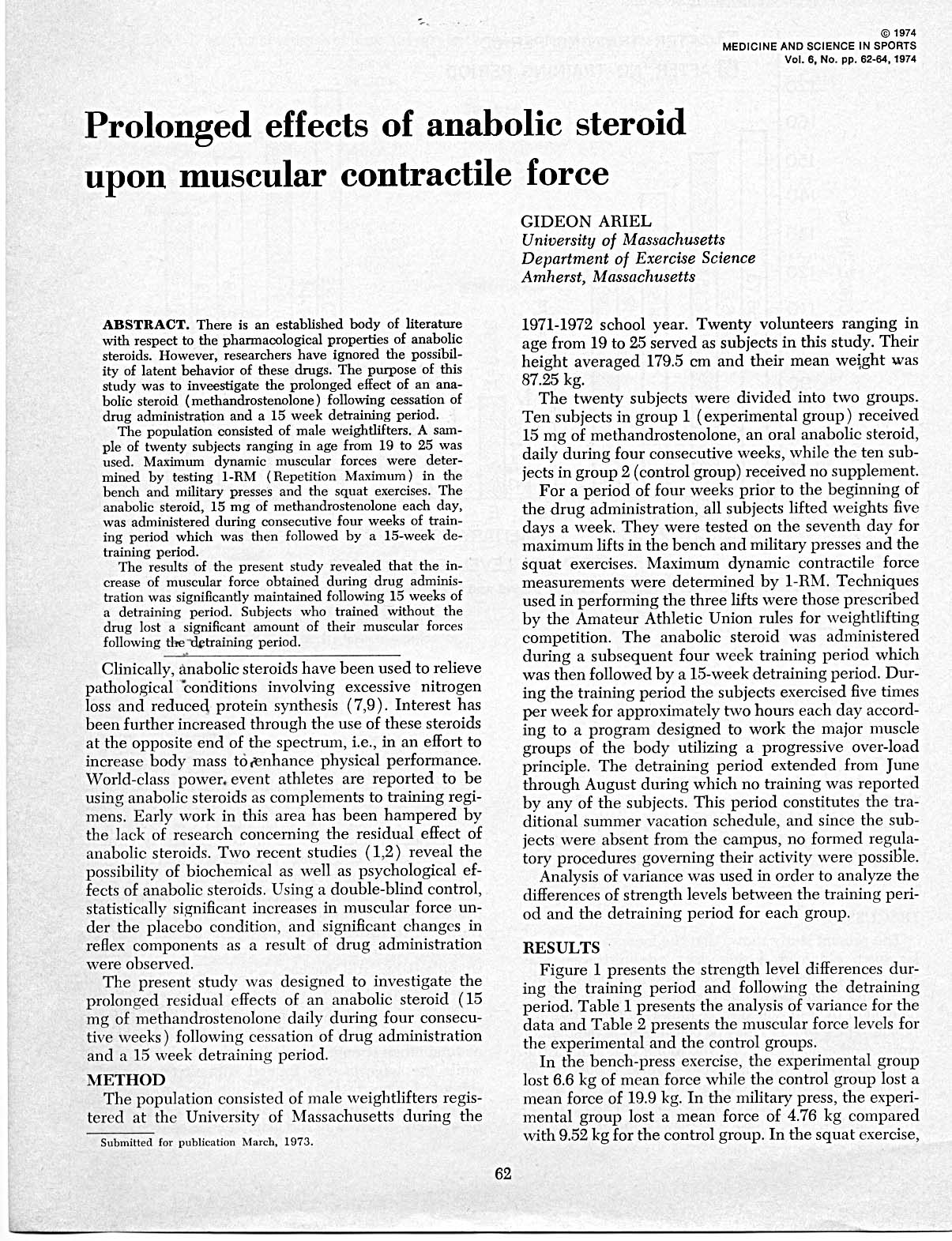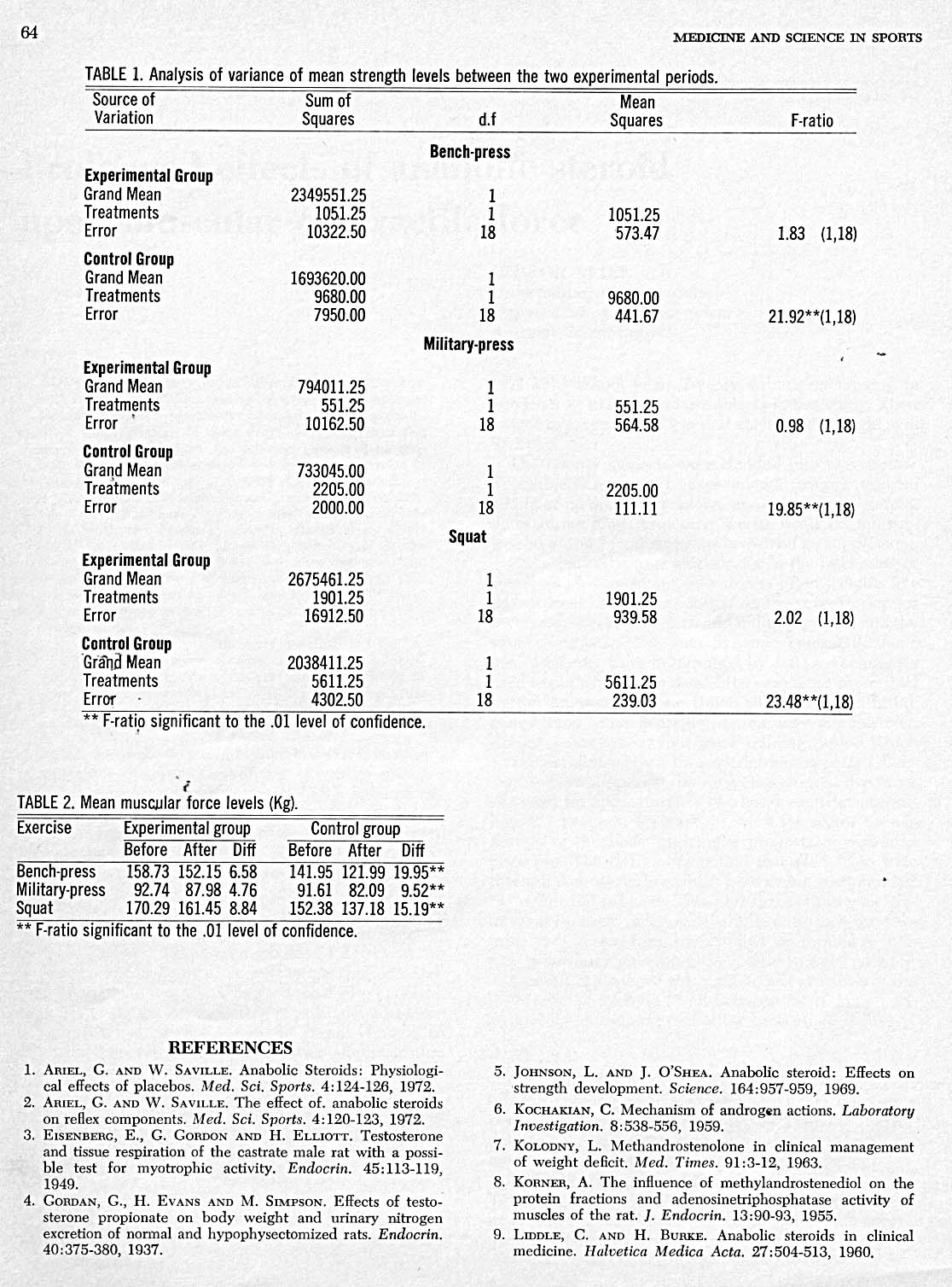Prolonged effects of anabolic steroid upon muscular contractile force
Researchers have ignored the possibility of latent behavior of these drugs. The purpose of this study was to inveestigate the prolonged effect of an anabolic steroid
By Gideon Ariel in Medicine and Science in Sports on Tuesday, July 23, 1974
Prolonged Effects of Anabolic Steroid upon Muscular Contractile Force
This 1974 study investigated the prolonged effects of an anabolic steroid (methandrostenolone) on muscular contractile force in male weightlifters. The study involved a sample of twenty subjects aged between 19 to 25. The subjects were divided into two groups, with one group receiving 15 mg of methandrostenolone daily for four consecutive weeks, while the other group received no supplement.
The results revealed that the increase in muscular force obtained during drug administration was significantly maintained following a 15-week detraining period. In contrast, subjects who trained without the drug lost a significant amount of their muscular forces following the detraining period.
The study concluded that anabolic steroids could be actively involved in the maintenance of strength, even after a period of detraining. This suggests that the use of anabolic steroids may have long-term effects on muscle strength, beyond the period of active use.
Tip: use the left and right arrow keys
� 1974
MEDICINE AND SCIENCE IN SPORTS
Vol. 6, No. pp. 62-64,1974
Prolonged effects of anabolic steroid
upon muscular contractile force
ABSTRACT. There is an established body of literature with respect to the pharmacological properties of anabolic steroids. However, researchers have ignored the possibility of latent behavior of these drugs. The purpose of this
study was to inveestigate the prolonged effect of an anabolic steroid (methandrostenolone) following cessation of drug administration and a 15 week detraining period.
The population consisted of male weightlifters. A sample of twenty subjects ranging in age from 19 to 25 was used. Maximum dynamic muscular forces were determined by testing 1-RMM (Repetition Maximum) in the
bench and military presses and the squat exercises. The anabolic steroid, 15 mg of methandrostenolone each day, was administered during consecutive four weeks of train
ing period which was then followed by a 15-week detraining period.
The results of the present study revealed that the increase of muscular force obtained during drug administration was significantly maintained following 15 weeks of
a detraining period. Subjects who trained without the drug lost a significant amount of their muscular forces following the detraining period.
Clinically, anabolic steroids have been used to relieve pathological conditions involving excessive nitrogen loss and reduced protein synthesis (7,9). Interest has been further increased through the use of these steroids at the opposite end of the spectrum, i.e., in an effort to increase body mass torfinhance physical performance. World-class power. event athletes are reported to be using anabolic steroids as complements to training regimens. Early work in this area has been hampered by the lack of research concerning the residual effect of anabolic steroids. Two recent studies (1,2) reveal the possibility of biochemical as well as psychological effects of anabolic steroids. Using a double-blind control, statistically significant increases in muscular force under the placebo condition, and significant changes in reflex components as a result of drug administration were observed.
The present study was designed to investigate the prolonged residual effects of an anabolic steroid (15 mg of methandrostenolone daily during four consecutive weeks) following cessation of drug administration and a 15 week detraining period.
METHOD
The population consisted of male weightlifters registered at the University of Massachusetts during the
Submitted for publication March, 1973.
GIDEON ARIEL
University of Massachusetts Department of Exercise Science Amherst, Massachusetts
1971-1972 school year. Twenty volunteers ranging in age from 19 to 25 served as subjects in this study. Their height averaged 179.5 cm and their mean weight was 87.25 kg.
The twenty subjects were divided into two groups. Ten subjects in group 1 (experimental group) received 15 mg of methandrostenolone, an oral anabolic steroid, daily during four consecutive weeks, while the ten subjects in group 2 (control group) received no supplement.
For a period of four weeks prior to the beginning of the drug administration, all subjects lifted weights five days a week. They were tested on the seventh day for maximum lifts in the bench and military presses and the squat exercises. Maximum dynamic contractile force measurements were determined by 1-RM1. Techniques used in performing the three lifts were those prescribed by the Amateur Athletic Union rules for weightlifting competition. The anabolic steroid was administered during a subsequent four week training period which was then followed by a 15-week detraining period. During the training period the subjects exercised five times per week for approximately two hours each clay according to a program designed to work the major muscle groups of the body utilizing a progressive over-load principle. The detraining period extended from June through August during which no training was reported by any of the subjects. This period constitutes the traditional summer vacation schedule, and since the subjects were absent from the campus, no formed regulatory procedures governing their activity were possible.
Analysis of variance v vas used in order to analyze the differences of strength levels between the training period and the detraining period for each group.
RESULTS
Figure 1 presents the strength level differences during the training period and following the detraining period. Table 1 presents the analysis of variance for the data and Table 2 presents the muscular force levels for the experimental and the control groups.
In the bench-press exercise, the experimental group lost 6.6 kg of mean force while the control group lost a mean force of 1.9.9 kg. In the military press, the experimental group lost a mean force of 4.76 kg compared with 9.52 kg for the control group. In the squat exercise,
62
PROLONGED F:FFECTS OF ANABOLIC STLHOIDS
63
180 170 160 150
140
rn
z 130 w 120
U
0 110
0 AFTER TRAINING PERIOD AFTER NO TRAINING PERIOD
r
LO
In
1 00
90 80
N
Ix
0 N OD
Ix
U)
n IX
tp
'70
-
Ix
E E C C E E C C E
BENCH PRESS MILITARY PRESS
E C SQUAT
STRENGTH LEVEL DIFFERENCES
Figure 1. Strength level differences during the training period and following the detraining period.
i
the experimental group lost 8.44 kg compared with 15.19 kg for the control group.
Table 1 shows statistically significant differences in muscular strength level between the two experimental periods at the.01 level of confidence only for the control group.
DISCUSSION
The present study shows that the increase of muscular force obtained during drug administration was maintained following a 15 week detraining period. Subjects who trained without the drug lost a significant amount of their muscular force following the detraining period. These findings may be considered in the light of work of other investigators who found that administration of androgens and anabolic steroids results in the increased formation of extragenital protein-containing tissue (3,4,6). Part of this extragenital protein is formed in the skeletal muscle (6), and may be maintained dur
ing the detraining period. An increase of muscular tissue due to the administration of anabolic steroids was found by several investigators (6,8). Korner (8) found that the chemical composition of the protein newly formed by the influence of anabolic steroids was different from that of natural protein. Johnson and O'Shea (5) emphasized the need for a "severe" exercise regimen and a protein dietary supplement to accompany the administration of the drug. The genesis of increased muscular protein, which has been observed with all anabolic steroids (6), is still unclear.
CONCLUSION
It was observed in the present study that subjects who trained with the anabolic steroid were able to maintain their strength level after the detraining period, while the subjects who trained without the anabolic steroid demonstrated a significant loss of strength. hence, it is concluded that the anabolic steroid could be actively involved in the maintenance of strength.
64
M ICLNE AND SCIENCE LN SPORTS
TABLE 1. Analysis of variance of mean strength levels between the two experimental periods.
Source of Sum of d.f Mean F-ratio
Variation Squares Squares
Bench-press
Experimental Group 2349551.25 1
Grand Mean
Treatments 1051.25 1 1051.25
Error 10322.50 18 573.47 1.83 (1,18)
Control Group 1693620.00 1
Grand Mean
Treatments 9680.00 1 9680.00
Error 7950.00 18 441.67 21.92**(1,18)
Experimental Group 794011.25 Military-press
Grand Mean 1
Treatments 551.25 1 551.25
Error * 10162.50 18 564.58 0.98 (1,18)
Control Group 733045.00 1
Grand Mean
Treatments 2205.00 1 2205.00
Error 2000.00 18 111.11 19.85**(1,18)
Experimental Group 2675461.25 Squat
Grand Mean 1
Treatments 1901.25 1 1901.25
Error 16912.50 18 939.58 2.02 (1,18)
Control Group 2038411.25 1
Grand Mean
Treatments 5611.25 1 5611.25
Error - 4302.50 18 239.03 23.48**(1,18)
** F-ratio significant to the .01 level of confidence.
f
TABLE 2. Mean muscular force levels (Kg).
Exercise Experimental group Control group
Before After Diff Before After Diff
Bench-press 158.73 152.15 6.58 141.95 121.99 19.95**
Military-press 92.74 87.98 4.76 91.61 82.09 9.52**
Squat 170.29 161.45 8.84 152.38 137.18 15.19**
** F-ratio significant to the .01 level of confidence. REFERENCES
- ARIEL, G. AND NV. SAVILLE. Anabolic Steroids: Physiologi
cal effects of placebos. bled. Sci. Sports. 4:124-126, 1972. 2. AmEL, G. AND W. SAVILLE. The effect of. anabolic steroids
on reflex components. Med. Sci. Sports. 4:120-123, 1972.
- EISENBERC, E., G. GORDON AND H. ELLIOTT. Testosterone
and tissue respiration of the castrate male rat with a possi
ble test for myotrophic activity. Endocrin. 45:113-119,
1949.
GORDAN, G., H. EVANS AND Ml. SIMPSON. Effects of testosterone propionate on body weight and urinary nitrogen excretion of normal and hypophyscctomized rats. Endocrin. 40:375-380, 1937.
JOHNSON, L. AND J. O'SHEA. Anabolic steroid: Effects on strength development. Science. 164:957-959, 1969.
KOCHAKIAN, C. Mechanism of androgen actions. Laboratory
Investigation. 8:538-556, 1959.
- KOLODNY, L. Methhandrostenolone in clinical management
of weight deficit. bled. T nies. 91:3-12, 1963.
KORNER, A. The influence of methylandrostenediol on the protein fractions and adenosinetriphosphatasc activity of muscles of the rat. J. Endocrin. 13:90-93, 1955.
LIDDLE, C. AND H. Bun . Anabolic steroids in clinical medicine. Halvetica 1fedica Acta. 27:504-513, 1960.



